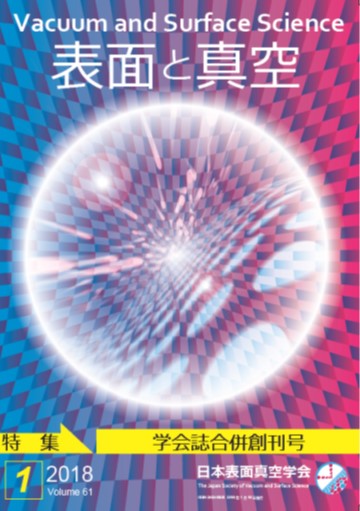Volume 64, Issue 3
Special Feature : Young Female Researchers in the Field of Vacuum and Surface Science
Displaying 1-10 of 10 articles from this issue
- |<
- <
- 1
- >
- >|
Special Feature : Young Female Researchers in the Field of Vacuum and Surface Science
-
Article type: Preface
2021 Volume 64 Issue 3 Pages 109
Published: March 10, 2021
Released on J-STAGE: March 10, 2021
Download PDF (353K) -
Article type: Introduction
2021 Volume 64 Issue 3 Pages 110-112
Published: March 10, 2021
Released on J-STAGE: March 10, 2021
Download PDF (586K) -
 Article type: Current Topics
Article type: Current Topics
2021 Volume 64 Issue 3 Pages 113-117
Published: March 10, 2021
Released on J-STAGE: March 10, 2021
-
Article type: Current Topics
2021 Volume 64 Issue 3 Pages 118-125
Published: March 10, 2021
Released on J-STAGE: March 10, 2021
Download PDF (5134K) -
Article type: Current Topics
2021 Volume 64 Issue 3 Pages 126-133
Published: March 10, 2021
Released on J-STAGE: March 10, 2021
Download PDF (5265K)
Review
-
Article type: Review
2021 Volume 64 Issue 3 Pages 134-139
Published: March 10, 2021
Released on J-STAGE: March 10, 2021
Download PDF (1029K)
Report
Conference Report
-
Article type: Report
2021 Volume 64 Issue 3 Pages 140
Published: March 10, 2021
Released on J-STAGE: March 10, 2021
Download PDF (270K) -
Article type: Report
2021 Volume 64 Issue 3 Pages 141
Published: March 10, 2021
Released on J-STAGE: March 10, 2021
Download PDF (399K)
Science Café
Research Abroad
-
Article type: Science Café
2021 Volume 64 Issue 3 Pages 142-143
Published: March 10, 2021
Released on J-STAGE: March 10, 2021
Download PDF (474K)
News & Trends
-
Article type: News & Trends
2021 Volume 64 Issue 3 Pages 144
Published: March 10, 2021
Released on J-STAGE: March 10, 2021
Download PDF (312K)
- |<
- <
- 1
- >
- >|




